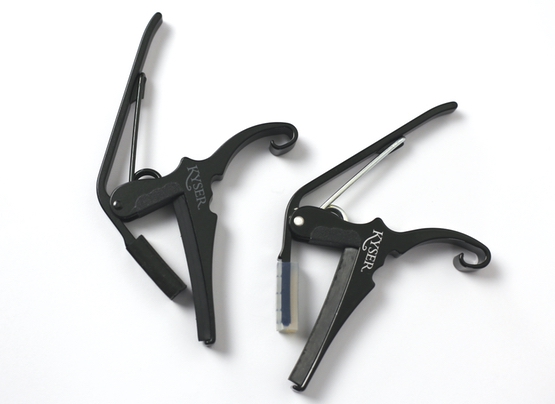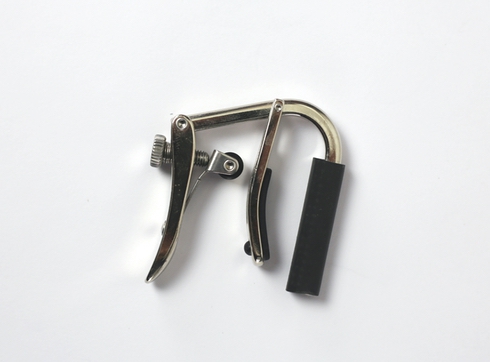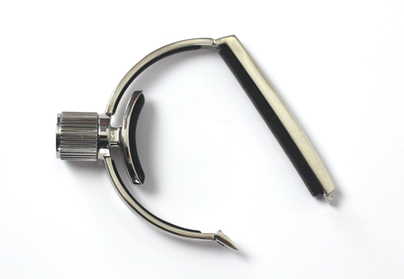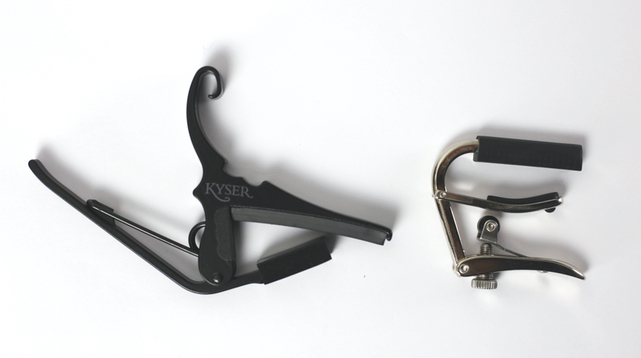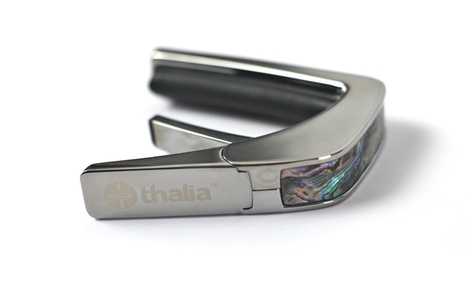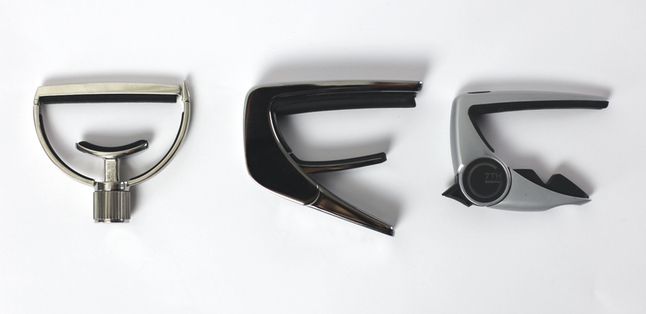Guitar Capos Compared
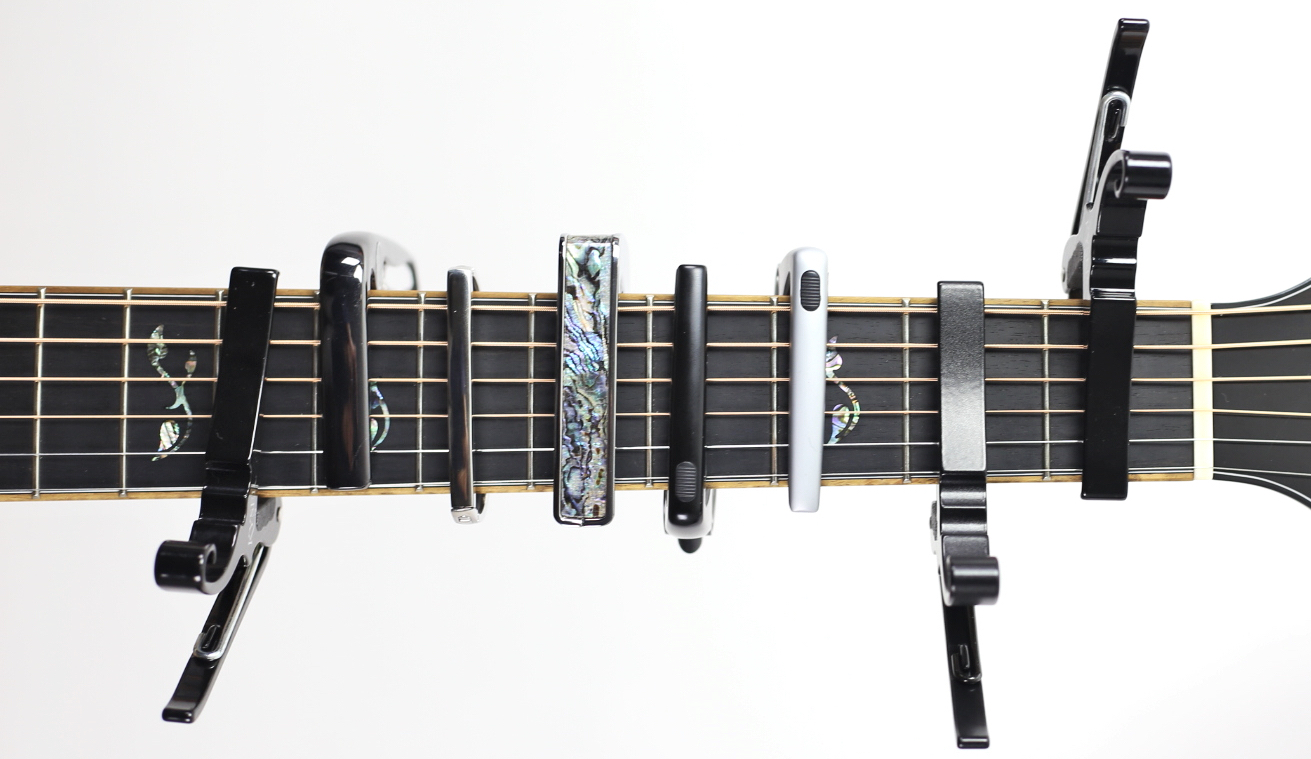
Capo Roundup and Comparison
(Updated May 28, 2018)
What are the differences between a $10 capo and a $100 capo? We set out to review all of the capos and let you decide for yourself!
What’s a capo?
Guitar capos work by transposingTransposing a song means to take all of the notes in the song and move them up or down by an equal amount. Depending on the result, this can make the song easier to perform. the open strings of the guitar to other notes, allowing the player to play open string-based chords in higher registers.
Capos are an important tool for any acoustic guitar player. They’re widely used in popular music. Singers love the ability to transpose a song instantly without changing any chord shapes. And solo acoustic guitar players depend on them to create arrangements in new keys. Some players use a capo all of the time.
Capos work by pressing down multiple strings at once at the same fret. The vast majority of capos press all of the strings of a single fret across, simulating a barre chordA chord that requires the use of a single finger to press down on multiple strings at once, in a straight row across the same fret. . Some capos, called partial capos, use a special design to press down only several of the strings, creating interesting combinations.
Typical Problems with Capos
Typical problems encountered by capo users:
- Capos are one-size-fits-all and may not be the ideal fit for every guitar
- Some capos are not wide enough to be used on higher frets
- If the tension of a capo is too low, there will be buzzing and muffled notes
- If the tension of the capo is too high, the guitar will sound out-of-tune
- Some capos are not as convenient to use or take too long to put on
Designing a one-size-fits-all capo is difficult. The capo must fit properly on the guitar. There are many different designs of guitars, so that is not so easy. Some capos fit on the lower frets but become unreliable on the higher frets as the shape of the neck widens.
Capos and Tuning Problems
Frequent capo users know that all capos affect intonation. We can prove this by tuning a guitar to perfect standard tuning. Apply any capo, to any fret, and then use a digital tuner to check the pitch again. You will almost certainly find that at least one string is now slightly out of tune.
It’s a good idea to use a fine-tune the instrument after applying a capo. Just remember to tune to the correct capo’d pitch, not the original open string pitch!
If all capos mess up the intonation of your guitar, why bother aiming for the perfect tension? If the tension is exactly correct, you may not need to retune. Even if you do retune, it will only be a very small adjustment. A quality capo will reduce the time you spend tuning, and help you sound more in-tune.
Fixed Tension Capos
Fixed-tension capos typically operate via a spring mechanism, or sometimes by an elastic band or strap that wraps around the neck of the guitar. They are often as little as $5, but a quality one may cost $25, and a premium one costs around $70.
Players who use fixed-tension capos like the ease and simplicity of use, as well as the affordable price. The weakness of this design is that the tension level cannot be optimized for all guitars. Spring-type capos typically apply too much tension, thus putting the guitar out of tune.
Tip: when not in use, most spring-based capos can be clipped onto the guitar head stock.
Kyser Quick-Change: affordable and reliable quick fixed tension capo
Kyser makes a quality capo that remains the favorite of many guitar players. They make separate capos for electric guitars and acoustic guitars. In addition, there is a "low tension" capo for acoustic guitar that works great on most modern acoustic guitars. Great for beginners or anyone who wants a no-fuss capo: Kyser Low-Tension Capo[?]Affiliate Link
Thalia Capo, highest quality fixed-tension capo
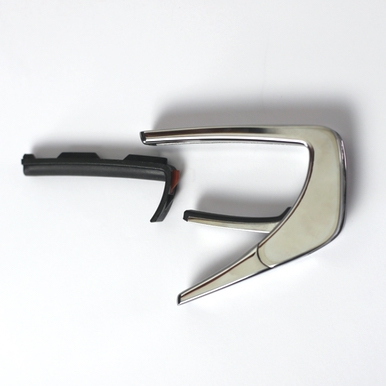
Not only are Thalia capos by far the most visually appealing, but they also come with custom pads designed to fit every brand of guitar.
Thalia capos come with a variety of inlays, from abalone to rosewood. That makes them the most customizable and “visually appealing” capo.
In addition to being visually striking, the Thalia capo also attempts to solve a problem most capos have, which is that the tension is not distributed evenly across the 6 strings due to differences in fretboard radiusThe radius of a fretboard refers to its curvature. A fretboard with no radius is perfectly flat from low E to high e. A fretboard with a radius will be slightly higher in the middle and lower on the ends. . Thalia capos come with interchangeable pads designed for different fretboards, allowing you to get the perfect fit. The included manual helpfully suggests a pad for almost every brand of guitar.
This capo is more expensive, but highly recommended: Thalia Capo[?]Affiliate Link
Other capos we compared included the Paige Spring Capo, G7th Nashville, Nordic Essentials, Jim Dunlop, and Fender capos.
Adjustable Tension Capos
Adjustable tension capos allow the player to dial in the perfect amount of tension, stopping after the strings all ring clearly but before they start to go out of tune.
Tip: For adjustable-tension capos, the ideal tension is the minimum amount of tension at which all strings can ring open, free of muffled sounds, and no more.
Shubb S1 Capo
Schubb capos feature a brilliant design very similar to the spring capo. The Shubb capo uses a clamp, but the tension is adjustable with a thumb screw. This allows you to clamp it on and dial in the ideal amount of tension. Since the adjustment is made by thumb screw, the capo will also tend to “remember” the tension you used previously. Shubb is probably the best compromise between quality, price, and performance of any of the capos tested: Shubb Capo S1[?]Affiliate Link
G7th Performance
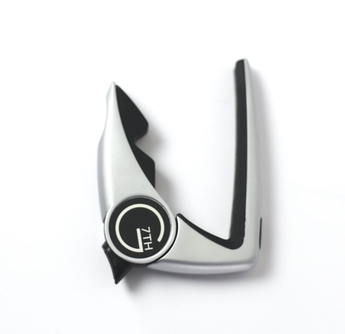
Perhaps the most appealing capo for the professional, the G7th Performance is easy to use and can be easily adjusted to the ideal tension.
The G7th capo uses a ratchet mechanism, similar to that of a car parking brake. As you engage the capo on a given fret, you apply a small amount of pressure to squeeze it onto the fret, squeezing more to lock the ratchet into tighter stages. You can do this with one hand, and in a short time you will learn the “ideal” pressure to use for your guitar. G7th capos are extremely easy to use one-handed, are fast at changing positions due to a quick-release, and also affect the tuning only minimally. The G7th capo is perfect for professionals or anyone who wants the top-performing capo. G7th Performance[?]Affiliate Link
G7th Heritage
Not afraid to outdo themselves, (and apparently not satisfied enough having created the G7th Performance[?]Affiliate Link, which is already one of the very best capos available), the folks at G7th decided to come up with a capo that could never be beat.
The Heritage uses a more traditional-style mechanism and a thumb screw. It is made of gleaming stainless steel, and is engineered to the highest quality, with no shortcuts taken. The Heritage is a capo that seems certain to last for generations.
The Heritage also features an adaptive radius technology, meaning that in addition to adjustable tension, the capo is designed to fit with any guitar radius. That makes it the best-performing capo available.
If you’re looking for an ultra-premium capo, this is the one for you! G7th Heritage[?]Affiliate Link
Results
Best (Affordable) Capo
The Kyser Low-Tension Capo[?]Affiliate Link is one of the best choices for beginners because most can figure it out in a moment’s time, provided they do not attempt to put it on upside-down.
More experienced players should consider the Shubb Capo S1[?]Affiliate Link due to its quality construction and adjustable tension.
Most Beautiful Capo
The Thalia Capo[?]Affiliate Link is by far the most beautiful, which is why you see many artists using this capo on YouTube. But they’re not just for looks. Thalia is one of the highest quality capos available, and the only one to feature interchangeable pads, allowing the capo to be converted to any instrument or even a partial capo!
Top Quality Capo
Three capos stood out for having best overall quality: the G7th Performance[?]Affiliate Link, the Thalia Capo[?]Affiliate Link, and the G7th Heritage[?]Affiliate Link.
The Thalia Capo is a contender due to its overall construction quality and interchangeable pads.
For the professional, the G7th Performance 2 combines the best of all worlds. It’s easy to apply, has an adjustable tension, and affects the tuning of the guitar only minimally. It’s also reasonably affordable.
For a truly premium capo, the G7th Heritage capo combines the yoke-style thumbscrew-based tension in an incredibly well-engineered all stainless steel design. This is a capo that is likely to outlast you.
 As the creator of Hub Guitar, Grey has compiled hundreds of guitar lessons, written several books, and filmed hundreds of video lessons. He teaches private lessons in his Boston studio, as well as via video chat through TakeLessons.
As the creator of Hub Guitar, Grey has compiled hundreds of guitar lessons, written several books, and filmed hundreds of video lessons. He teaches private lessons in his Boston studio, as well as via video chat through TakeLessons.